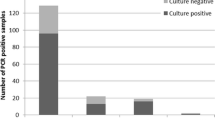Abstract
The sensitivity and specificity of the polymerase chain reaction (PCR) for detection of DNA sequences specific toShigella spp. and enteroinvasiveEscherichia coli (EIEC) in stools was evaluated. Stool specimens were obtained from patients with acute gastroenteritis before and after antibiotic treatment. Fecal material was pre-incubated in phosphate-buffered saline, gram-negative broth or brain heart infusion (BHI) broth, and DNA was extracted and amplified. Primers complementary to theial or thevirF loci of the 140 MDa plasmid ofShigella were evaluated. The highest sensitivity for detection ofShigella DNA in stools (higher than that of culture) was reached by pre-incubation of the fecal material in BHI broth and use ofvirF primers for amplification. The specificity of this PCR protocol was documented by the negative results obtained with non-Shigella enteric organisms. These findings point out the important diagnostic and epidemiologic potential of thevirF-specific PCR protocol in the investigation ofShigella infections.
Similar content being viewed by others
References
Keusch TG, Bennish ML Shigellosis. In: Evans AS, Brachman PS (ed): Bacterial Infections in Humans. Plenum Medical Book Co., New York, 1991, p. 593–620.
DuPont HL, Levine MM, Hornick RB, Formal SB Inoculum size shigellosis and implications for expected mode of transmission. Journal of Infectious Diseases 1989, 159: 1126–1128.
Blaser MJ, Pollard RA, Feldman RA Shigella infections in the United States, 1974–1980. Journal of Infectious Diseases 1983, 147: 771–775.
Daniell ED, Crafton LD, Walz SE, Botton HT Field preventive medicine and epidemiological surveillance; the Beirut, Lebanon experience. Military Medicine 1985, 150: 171–176.
Green MS, Cohen D, Block C, Rouach T, Dycian RA Prospective epidemiologic study of shigellosis. Implications for the new shigella vaccines. Israel Journal of Medical Sciences 1987, 23: 811–815.
Green MS, Block C, Cohen D, Slater P Four decades of shigellosis in Israel — the epidemiology of a growing public health problem. Reviews of Infectious Diseases 1991, 13: 248–253.
Farmer JJ III, Kelly MT Enterobacteriaceae. In: Balows A, Hausler Jr WJ, Herrmann KL, Isenberg HD, Shadomy HJ (ed.): Manual of clinical microbiology. American Society for Microbiology, Washington, DC, 1991. p. 360–383.
Frankel G, Riley L, Giron JA Detection ofShigella in feces using DNA amplification. Journal of Infectious Diseases 1990, 161: 1252–1256.
Sakai S, Sasakawa C, Makino S, Yoshikawa M DNA sequence and product analysis of thevirF locus responsible for Congo red binding and cell invasion inShigella flexneri 2a. Infection and Immunity 1986, 54: 395–402.
Venkatesan M, Fernandez-Prada C, Buysse JM, Formal SB Virulence phenotype and genetic characteristics of the T32-IstratiShigella flexneri 2a vaccine strain. Vaccine 1991, 9: 358–363.
Victor T, du Toit R, van Zyl J, Bester AJ, van Helden PD Improved method for the routine identification of toxigenicEscherichia coli by DNA amplification of a conserved region of the heat-labile toxic A subunit. Journal of Clinical Microbiology 1991, 29: 158–161.
Jiang X, Wang J, Graham DY, Estes MK Detection of Norwalk virus in stool by polymerase chain reaction. Journal of Clinical Microbiology 1992, 30: 2529–2534.
Saulnier P, Andremont A Detection of genes in feces by booster polymerase chain reaction. Journal of Clinical Microbiology 1992, 30: 2080–2083.
Brisson-Noel A, Aznar C, Chureau C, Nguyen S, Pierre C, Bartoli M, Bonete R, Pialoux G, Gicquel B,Garrigue G: Diagnosis of tuberculosis by DNA amplification. Lancet 1991, 338: 364–366.
Sethabutr O, Venkatesan M, Murphy GS, Eampokalap B, Hoge CH, Echeverria P Detection of Shigellae and enteroinvasive Escherichia coli by amplification of the invasion plasmid antigen H DNA sequence in patients with dysentery. Journal of Infectious Diseases 1993, 167: 548–461.
Author information
Authors and Affiliations
Rights and permissions
About this article
Cite this article
Yavzori, M., Cohen, D., Wasserlauf, R. et al. Identification ofShigella species in stool specimens by DNA amplification of different loci of theShigella virulence plasmid. Eur. J. Clin. Microbiol. Infect. Dis. 13, 232–237 (1994). https://doi.org/10.1007/BF01974542
Issue Date:
DOI: https://doi.org/10.1007/BF01974542



